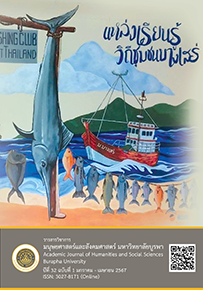Semiotic of Disabled Body in Television Commercials
Main Article Content
Abstract
This research aimed to study the significance of the bodies of people with disabilities in television commercials using qualitative research methods by analyzing the textual analysis that focuses on presenting the disabled body as the main character in the story, consisting of a visually impaired body. Bodies with hearing or communication disabilities, bodies with mobility or physical disability, and bodies with learning disabilities, a total of 6 stories using a theoretical framework, including the concept of the body of people with disabilities, concepts of semiotics, and storytelling and advertising concepts. The research results found that the symbolic interpretation of the body of the disabled in commercials can be divided into three forms: 1) weak body and pitiful, that is, the owner of the body is unable to help himself, which is a physical disability that affects the mind physical disability has become a constraint on living life or participating in society. 2) A body that must prove its abilities; that is, even though people in society reject disabled bodies, people with disabilities have had their bodies proven so that society accepts them in their knowledge, ability, and ability to live everyday life like ordinary people. 3) A body with the same potential as an average person is a step beyond the body’s limits. Becoming a body full of abilities with admirable value can create a career and income.
Downloads
Article Details

This work is licensed under a Creative Commons Attribution-NonCommercial-NoDerivatives 4.0 International License.
บทความทุกบทความเป็นลิขสิทธิ์ของวารสารวิชาการมนุษยศาสตร์และสังคมศาสตร์ มหาวิทยาลัยบูรพาเท่านั้น
References
กุลภา วจนสาระ. (2548). ภาพตัวแทนสังคมของคนพิการในสังคมไทย: กรณีศึกษาผ่านวรรณกรรมไทย. [รายงานการวิจัย] ศูนย์สิรินธรเพื่อการฟื้นฟูสมรรถภาพทางการแพทย์แห่งชาติ.
ฐิติวัจน์ ทองแก้ว และพิทักษ์ ศิริวงศ์. (2559). การสร้างพื้นที่ทางสังคมและการดำรงอัตลักษณ์ของคนพิการที่ทำงานในองค์กรด้านการสื่อสารโทรคมนาคม. วารสารวิชาการ Veridian E–Journal, Silpakorn University, 9(3), 1443-1462.
ธัญวลัย จารุเฉลิมพันธ์. (2553). การสร้างความตระหนักในสิทธิและโอกาสทางสังคมของคนพิการทางร่างกายและการเคลื่อนไหว. ภาควิชาสังคมสงเคราะห์ศาสตร์ คณะสังคมสงเคราะห์ศาสตร์ มหาวิทยาลัยธรรมศาสตร์.
ธนพล แสงจันทร์. (2555). การเสริมสร้างเครือข่ายการดำรงชีวิตอิสระของคนพิการ กรณีศึกษา: ศูนย์การดำรงชีวิตอิสระของคนพิการพุทธมณฑล. [วิทยานิพนธ์ศึกษาศาสตรมหาบัณฑิต, มหาวิทยาลัยศิลปากร].
เนตรชนก สุนา. (2556). เจตคติของคนพิการต่อการเสริมสร้างพลังอำนาจ. วารสารวิทยาลัยราชสุดาเพื่อการวิจัยและพัฒนาคนพิการ, 9(12), 4-21.
นิธิ เอียวศรีวงศ์. (2538). ผ้าขาวม้า, ผ้าซิ่น, กางเกงใน และฯลฯ ว่าด้วยประเพณี, ความเปลี่ยนแปลง และเรื่องสรรพสาระ. มติชน.
ปราง ธาระวานิช. (2563). การสื่อสารอัตลักษณ์คนพิการทางการเคลื่อนไหวผ่านเว็บไซต์ข่าวในประเทศไทย. วารสารวิทยาลัยราชสุดาเพื่อการวิจัยและพัฒนาคนพิการ, 16(1), 99-114.
พัชรี กล่อมเมือง. (2562). คนชายขอบ: ชาวไทยเชื้อสายมลายูในสามจังหวัดชายแดนภาคใต้. วารสารวิชาการมหาวิทยาลัยกรุงเทพธนบุรี, 8(2), 1-10.
วิชัย จันทร์บุญ และมณีมัย ทองอยู่. (2559). กระบวนการต่อสู้ต่อความเชื่อทางสังคมของคนพิการ. วารสารวิจัยและพัฒนา วไลยอลงกรณ์ ในพระบรมราชูปถัมภ์ สาขามนุษยศาสตร์และสังคมศาสตร์, 11(1), 171-181.
ศวิตา ศีลตระกูล. (2563). การสร้างสรรค์ภาพยนตร์สารคดีสั้นที่มีเนื้อหาเกี่ยวกับผู้ที่มีภาวะดาวน์ซินโดรม. [ปริญญานิพนธ์ศิลปศาสตรมหาบัณฑิต, มหาวิทยาลัยศรีนครินทรวิโรฒ].
สุชาติ พันธุ์ลาภ และนพพร จันทรนำชู. (2564). รูปแบบการเปลี่ยนผ่านอัตลักษณ์ไปสู่การดำรงชีวิตอิสระของคนพิการ. วารสารนวัตกรรมการศึกษาและการวิจัย, 5(3), 673-686.
อธิภัทร เอิบกมล. (2565). ที่รักอย่าจากฉันไป: ชีวิต เลือดเนื้อ และการต่อสู้ของผู้พิการในวรรณกรรมของเจิ้งฟงสี่. วารสารปาริชาต มหาวิทยาลัยทักษิณ, 35(3), 1-17.
Barthes, R. (1993). Mythologies. Cox & Wymand.
Girli, A., Sari, H. Y., Kirkim, G., & Narin, S. (2016). University students’ attitudes towards disability and their views on discrimination. International Journal of Developmental Disabilities, 62(2), 98-107.
HealthServ. (2565). รายงานข้อมูลสถานการณ์ด้านผู้พิการในประเทศไทย กระทรวงการพัฒนาสังคมและความมั่นคงของมนุษย์ ปี 2564. https://healthserv.net/healthupdate/13140#
Suwaphan, D. (Ed.). (2010). Handbook of evaluation and diagnosis for disability. National Office for Empowerment of Persons with Disabilities.


